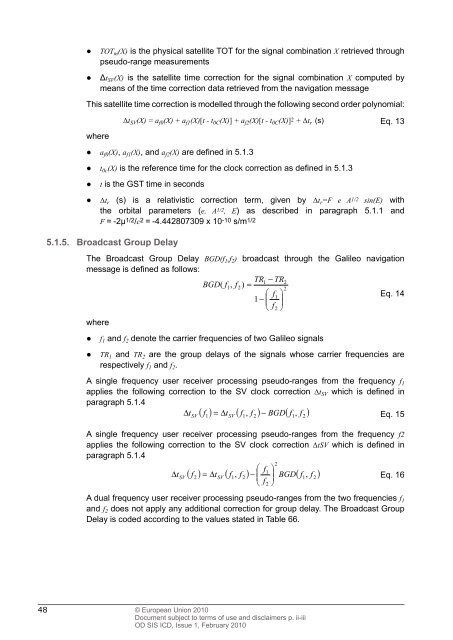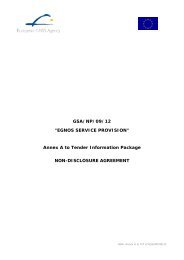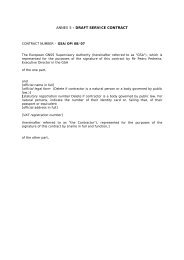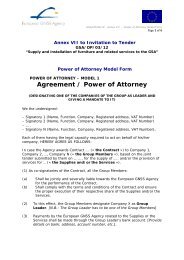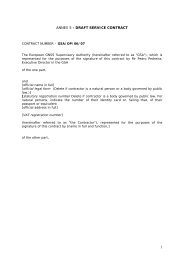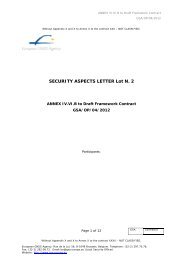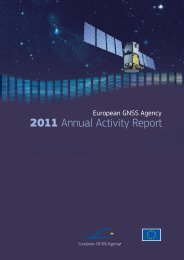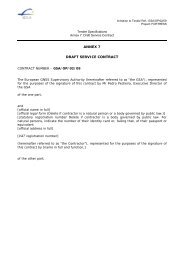Galileo OS SIS ICD.indd - GSA - Europa
Galileo OS SIS ICD.indd - GSA - Europa
Galileo OS SIS ICD.indd - GSA - Europa
Create successful ePaper yourself
Turn your PDF publications into a flip-book with our unique Google optimized e-Paper software.
● TOT m(X) is the physical satellite TOT for the signal combination X retrieved through<br />
pseudo-range measurements<br />
● Δt SV(X) is the satellite time correction for the signal combination X computed by<br />
means of the time correction data retrieved from the navigation message<br />
This satellite time correction is modelled through the following second order polynomial:<br />
where<br />
Δt SV(X) = a f0(X) + a f1(X)[t - t 0C(X)] + a f2(X)[t - t 0C(X)] 2 + Δt r (s) Eq. 13<br />
● a f0(X), a f1(X), and a f2(X) are defi ned in 5.1.3<br />
● t 0c(X) is the reference time for the clock correction as defi ned in 5.1.3<br />
● t is the GST time in seconds<br />
● Δt r (s) is a relativistic correction term, given by Δt r=F e A 1/2 sin(E) with<br />
the orbital parameters (e, A 1/2, E) as described in paragraph 5.1.1 and<br />
F = -2μ 1/2/c 2 = -4.442807309 x 10 -10 s/m 1/2<br />
5.1.5. Broadcast Group Delay<br />
The Broadcast Group Delay BGD(f1,f2) broadcast through the <strong>Galileo</strong> navigation<br />
message is defi ned as follows:<br />
TR1<br />
− TR2<br />
BGD(<br />
f1,<br />
f2<br />
) =<br />
2<br />
� f � 1<br />
Eq. 14<br />
1 − �<br />
�<br />
�<br />
�<br />
� f2<br />
�<br />
where<br />
● f 1 and f 2 denote the carrier frequencies of two <strong>Galileo</strong> signals<br />
● TR 1 and TR 2 are the group delays of the signals whose carrier frequencies are<br />
respectively f 1 and f 2.<br />
A single frequency user receiver processing pseudo-ranges from the frequency f1 applies the following correction to the SV clock correction ΔtSV which is defi ned in<br />
paragraph 5.1.4<br />
Δ ( f ) = Δt<br />
( f , f ) − BGD(<br />
f , f )<br />
Eq. 15<br />
tSV 1 SV<br />
48 © European Union 2010<br />
Document subject to terms of use and disclaimers p. ii-iii<br />
OD <strong>SIS</strong> <strong>ICD</strong>, Issue 1, February 2010<br />
1<br />
A single frequency user receiver processing pseudo-ranges from the frequency f2<br />
applies the following correction to the SV clock correction ΔtSV which is defi ned in<br />
paragraph 5.1.4<br />
2<br />
f<br />
tSV 2 SV 1 2<br />
f �<br />
2<br />
�<br />
� �<br />
�<br />
2<br />
1<br />
( f ) = Δt<br />
( f , f ) − � BGD(<br />
f , f )<br />
Δ 1 2<br />
Eq. 16<br />
� �<br />
A dual frequency user receiver processing pseudo-ranges from the two frequencies f 1<br />
and f 2 does not apply any additional correction for group delay. The Broadcast Group<br />
Delay is coded according to the values stated in Table 66.<br />
1<br />
2


